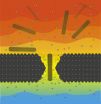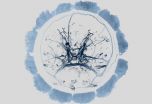(Press-News.org) CINCINNATI – New research shows that disrupting the molecular function of a tumor suppressor causes improper formation of a protective insulating sheath on peripheral nerves – leading to neuropathy and muscle wasting in mice similar to that in human diabetes and neurodegeneration.
Scientists from Cincinnati Children's Hospital Medical Center report their findings online Sept. 26 in Nature Communications. The study suggests that normal molecular function of the tumor suppressor gene Lkb1 is essential to an important metabolic transition in cells as peripheral nerves (called axons) are coated with the protective myelin sheath by Schwann glia cells.
"This study is just the tip of the iceberg and a fundamental discovery because of the unexpected finding that a well-known tumor suppressor gene has a novel and important role in myelinating glial cells," said Biplab Dasgupta PhD, principal investigator and a researcher at the Cincinnati Children's Cancer and Blood Diseases Institute (CBDI). "Additional study is needed, as the function of Lkb1 may have broader implications – not only in normal development, but also in metabolic reprogramming in human pathologies. This includes functional regeneration of axons after injury and demyelinating neuropathies."
The process of myelin sheath formation (called myelination) requires extraordinarily high levels of lipid (fat) synthesis because most of myelin is composed of lipids, according to Dasgupta. Lipids are made from citric acid which is produced in the powerhouse of cells called mitochondria. Success of this sheathing process depends on the cells shifting from a glycolytic to mitochondrial oxidative metabolism that generates citric acid, the authors report.
Dasgupta's research team used Lkb1 mutant mice in the current study. Because the mice did not express Lkb1 in myelin forming glial cells, this allowed scientists to analyze its role in glial cell metabolism and formation of the myelin sheath coating.
When the function of Lkb1 was disrupted in laboratory mice, it blocked the metabolic shift from glycolytic to mitochondrial metabolism, resulting in a thinner myelin sheath (hypomyelination) of the nerves. This caused muscle atrophy, hind limb dysfunction, peripheral neuropathy and even premature death of these mice, according to the authors.
Peripheral neuropathy involves damage to the peripheral nervous system – which transmits information from the brain and spinal cord (the central nervous system) to other parts of the body, according to the National Institute of Neurological Disorders and Stroke (NINDS). There are more than 100 types of peripheral neuropathy, and damage to the peripheral nervous system interferes with crucial messages from the brain to the rest of the body.
The scientists also reported that reducing Lkb1 in Schwann cells decreased the activity of critical metabolic enzyme citrate synthase that makes citric acid. Enhancing Lkb1 increased this activity.
They tested the effect of boosting citric acid levels in the Lbk1 mutant Schwann cells. This enhanced lipid production and partially reversed myelin sheath formation defects in Lbk1 mutant Schwann cells. Dasgupta said this further underscores the importance of Lbk1 and the production of citrate synthase.
Dasgupta and his colleagues are currently testing whether increasing the fat content in the Lbk1 mutant mice diet improves hypomyelination defects. The researchers emphasized the importance of additional research into the laboratory findings to extend their relevance more directly to human disease.
INFORMATION:
Funding support for the research came from the Trustee Scholar Award from Cincinnati Children's and the National Institute of Health (1R01NS075291-01A1).
About Cincinnati Children’s:
Cincinnati Children’s Hospital Medical Center ranks third in the nation among all Honor Roll hospitals in U.S. News and World Report’s 2014 Best Children’s Hospitals. It is also ranked in the top 10 for all 10 pediatric specialties. Cincinnati Children’s, a non-profit organization, is one of the top three recipients of pediatric research grants from the National Institutes of Health, and a research and teaching affiliate of the University of Cincinnati College of Medicine. The medical center is internationally recognized for improving child health and transforming delivery of care through fully integrated, globally recognized research, education and innovation. Additional information can be found at www.cincinnatichildrens.org. Connect on the Cincinnati Children’s blog, via Facebook and on Twitter. END
Study identifies unexpected clue to peripheral neuropathies
2014-09-26
ELSE PRESS RELEASES FROM THIS DATE:
NASA identifies cold cloud tops in Tropical Storm Rachel
2014-09-26
NASA's Aqua satellite saw the area of strong thunderstorms with colder cloud tops had grown within the Eastern Pacific Ocean's Tropical Storm Rachel.
NASA's Aqua satellite passed over the large Tropical Storm Rachel on Sept. 25 at 4:41 p.m. EDT and the Atmospheric Infrared Sounder or AIRS instrument, saw that the extent of colder cloud tops had increased, indicating thunderstorm heights were increasing and it was strengthening. The expansion of those stronger thunderstorms also suggests that the northeasterly wind shear may be relaxing a little. The strongest thunderstorms ...
Underwater robot for port security
2014-09-26
Last week, at the International Conference on Intelligent Robots and Systems, MIT researchers unveiled an oval-shaped submersible robot, a little smaller than a football, with a flattened panel on one side that it can slide along an underwater surface to perform ultrasound scans.
Originally designed to look for cracks in nuclear reactors' water tanks, the robot could also inspect ships for the false hulls and propeller shafts that smugglers frequently use to hide contraband. Because of its small size and unique propulsion mechanism — which leaves no visible wake — the ...
Penn team studies nanocrystals by passing them through tiny pores
2014-09-26
An interdisciplinary team of University of Pennsylvania researchers has now applied a cutting-edge technique for rapid gene sequencing toward measuring other nanoscopic structures. By passing nanoscale spheres and rods through a tiny hole in a membrane, the team was able to measure the electrical properties of those structures' surfaces.
Their findings suggest new ways of using this technique, known as "nanopore translocation," to analyze objects at the smallest scale.
The research was led by Marija Drndić, professor in the Department of Physics and Astronomy ...
Geisel researchers contribute to study of trained immunity
2014-09-26
Hanover, NH - A study published in the journal Science provides support for a new—and still controversial—understanding of the immune system. The research was conducted by collaborators in the U.S. and Europe, including Robert Cramer, PhD, an assistant professor of microbiology and immunology at the Geisel School of Medicine and member of the Dartmouth Lung Biology Center, and Kelly Shepherdson, PhD, at the time a graduate student in Cramer's lab.
Typically, scientists divide the immune system into two categories: the innate immune response and the adaptive immune response. ...
New UT Dallas technology may lead to prolonged power in mobile devices
2014-09-26
Researchers from The University of Texas at Dallas have created technology that could be the first step toward wearable computers with self-contained power sources or, more immediately, a smartphone that doesn't die after a few hours of heavy use.
This technology, published online in Nature Communications, taps into the power of a single electron to control energy consumption inside transistors, which are at the core of most modern electronic systems.
Researchers from the Erik Jonsson School of Engineering and Computer Science found that by adding a specific atomic ...
High-throughput cell-sorting method can separate 10 billion bacterial cells in 30 minutes
2014-09-26
University of Hawaii at Manoa College of Engineering mechanical engineer Yi Zuo has developed a new, high-throughput method for sorting cells capable of separating 10 billion bacterial cells in 30 minutes.
The finding has already proven useful for studying bacterial cells and microalgae, and could one day have direct applications for biomedical research and environmental science—basically any field in which a large quantity of microbial samples need to be processed.
The new method was described in a September 2014 publication in the scientific journal Analytical Chemistry, ...
New scientific review of genetically engineered feeds in livestock diets
2014-09-26
An article published in the peer-reviewed Journal of Animal Science concludes feeding livestock diets that contain genetically engineered (GE) crops has no impact on the health or productivity of those animals. In a thorough review of scientific literature and field data sets, the article documents evidence that the performance and health of food-producing animals fed GE crops are comparable with those of animals fed non-GE crops.
Since their introduction in 1996, GE feed crops have become an increasing component of livestock diets. Today, more than 95 percent of U.S. ...
Experts call for widening the debate on climate change
2014-09-26
Environmental scientists are being urged to broaden the advice they give on global climate change, say experts who are also frustrated that decision makers are not taking enough action.
Writing in the journal Nature Climate Change, The University of Manchester researchers argue that scientists are expressing a strong desire to fix the problems highlighted by their studies into human-induced climate change
The authors suggest there are problems with environmental scientists offering practical solutions that can help societies adapt to a fast-changing Earth - one where ...
How plankton gets jet lagged
2014-09-26
A hormone that governs sleep and jet lag in humans may also drive the mass migration of plankton in the ocean, scientists at the European Molecular Biology Laboratory (EMBL) in Heidelberg, Germany, have found. The molecule in question, melatonin, is essential to maintain our daily rhythm, and the European scientists have now discovered that it governs the nightly migration of a plankton species from the surface to deeper waters. The findings, published online today in Cell, indicate that melatonin's role in controlling daily rhythms probably evolved early in the history ...
Green light for clever algae
2014-09-26
The researchers headed by Prof Dr Nicole Frankenberg-Dinkel have been the first ones to reveal similarities and differences in the assembly of the light-harvesting machinery of the cryptophyte Guillardia theta compared to cyanobacteria and red algae. The publication of their results in the current issue of "The Journal of Biological Chemistry" is among the two per cent of the publications that were selected as "Paper of the week".
Cryptophytes: Matryoshka dolls of the waters
Unlike traditional eukaryotic cells – i.e. all cells with a nucleus – cryptophyte cells resemble ...




